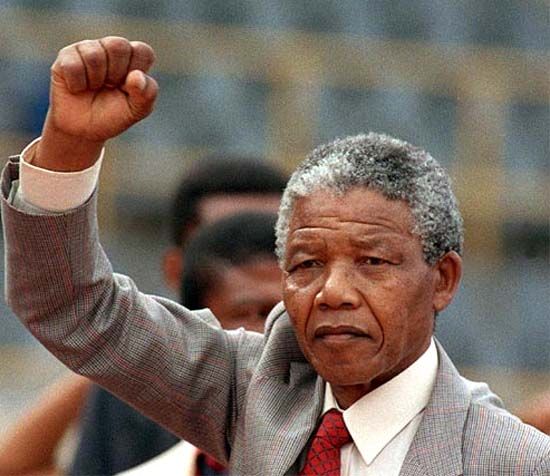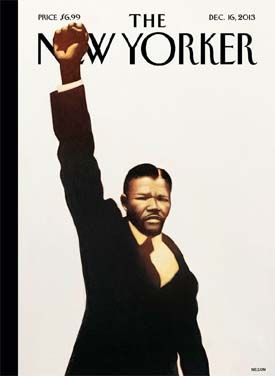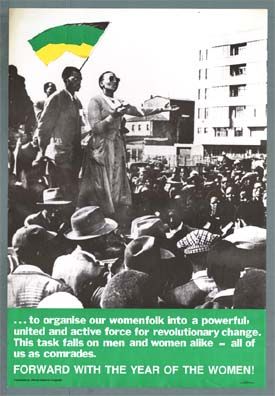Anti-apartheid leader and African National Congress (ANC) member Nelson Mandela raises clenched fist, arriving to address a mass rally, a few days after his release from jail.
South Africans and supporters world-wide continue to pay tribute to and honor Madiba, Nelson Mandela. You can visit the official SA government site for memorial and funeral events. From heads of state, to young schoolchildren, there has been an outpouring of condolences and sentiment.
The media coverage has been extensive-I’ve tried to look at as much as I can find-but so far the best and most comprehensive, imho, has been the live coverage from SABC TV, South African Broadcasting Corporation.
Coverage here in the U.S. has been varied, from laudatory to much of the usual carping and racism from the right, and many media outlets are already posting overly sanitized versions of his life and history, disconnected from his role and part in a struggle larger than one man, no matter his greatness. For those of you who may have missed it, please read shanikka’s Farewell Madiba, Who We Once Called Nelson Mandela
I found responses to the Mandela New Yorker cover to be particularly interesting.
The BBC has an interview with the artist, Kadir Nelson, who is also the author of Nelson Mandela, for children ages 4 – 8 years.
I wandered into the New Yorker blog comments section, and found some remarks particularly telling. Like this one:
jmen 3 days ago
Are there actually photographs of Mandela in that Black Power/Black Panther pose? It seems to me that no one was less about Black Power than he was.
As De Klerk said yesterday, “Nelson Mandela’s biggest legacy was . . . his remarkable lack of bitterness.”
Black power pose? A raised arm and clenched fist? The answer of course is yes-there are many such images-images that simply represent a struggle over decades that took the lives of so many who were fighting for freedom.
Another commenter posted from a very different perspective. It has been shared by thousands (with audio)
Mandela will never, ever be your minstrel.
Dear revisionists, Mandela will never, ever be your minstrel. Over the next few days you will try so, so hard to make him something he was not, and you will fail. You will try to smooth him, to sandblast him, to take away his Malcolm X. You will try to hide his anger from view. Right now, you are anxiously pacing the corridors of your condos and country estates, looking for the right words, the right tributes, the right-wing tributes. You will say that Mandela was not about race. You will say that Mandela was not about politics. You will say that Mandela was about nothing but one love, you will try to reduce him to a lilting reggae tune. “Let’s get together, and feel alright.” Yes, you will do that.
You will make out that apartheid was just some sort of evil mystical space disease that suddenly fell from the heavens and settled on all of us, had us all, black or white, in its thrall, until Mandela appeared from the ether to redeem us. You will try to make Mandela a Magic Negro and you will fail. You will say that Mandela stood above all for forgiveness whilst scuttling swiftly over the details of the perversity that he had the grace to forgive.You will try to make out that apartheid was some horrid spontaneous historical aberration, and not the logical culmination of centuries of imperial arrogance. Yes, you will try that too. You will imply or audaciously state that its evils ended the day Mandela stepped out of jail. You will fold your hands and say the blacks have no-one to blame now but themselves.
Well, try hard as you like, and you’ll fail. Because Mandela was about politics and he was about race and he was about freedom and he was even about force, and he did what he felt he had to do and given the current economic inequality in South Africa he might even have died thinking he didn’t do nearly enough of it. And perhaps the greatest tragedy of Mandela’s life isn’t that he spent almost thirty years jailed by well-heeled racists who tried to shatter millions of spirits through breaking his soul, but that there weren’t or aren’t nearly enough people like him. Because that’s South Africa now, a country long ago plunged headfirst so deep into the sewage of racial hatred that, for all Mandela’s efforts, it is still retching by the side of the swamp. Just imagine if Cape Town were London. Imagine seeing two million white people living in shacks and mud huts along the M25 as you make your way into the city, where most of the biggest houses and biggest jobs are occupied by a small, affluent to wealthy group of black people. There are no words for the resentment that would still simmer there.Nelson Mandela was not a god, floating elegantly above us and saving us. He was utterly, thoroughly human, and he did all he did in spite of people like you. There is no need to name you because you know who you are, we know who you are, and you know we know that too. You didn’t break him in life, and you won’t shape him in death. You will try, wherever you are, and you will fail.
My question is-will the traditional media fail? Will we wind up with yet another saintly Martin Luther King Jr. known only for “I have a dream” and “content of character”? Will it be like the historically incorrect images of that “tired older woman” who sat down on a bus one day-Rosa Parks?
Bloggers, educators, parents and teachers have to ensure that the life of the individual-Nelson Mandala-is firmly seated in an historical context, as well as part and parcel of the continuing struggle in South Africa to deal with not only the continuance of racism, but also of the severity and inequality of economic apartheid.
A good place to start is with the African National Congress (ANC) History, at their website, which is important to review if you don’t understand how long this struggle has been underway. It has nine sections:
1. The African Kingdoms are defeated 1860s – 1900
2. The ANC is formed – 1912
3. Working for a Wage
4. The ANC Gains New Life – 1940s
5. A Mass Movement is Born – 1950
6. The Armed Struggle Begins – 1960s
7. Workers and Students Fight Back – 1970s
8. The Struggle for People`s Power – 1980s
9. The ANC is Unbanned
While there, for visual images and video please visit the ANC archives
Poster: 1951 Defiance Campaign
Poster published by the ANC in 1984; designed by Thami Mnyele; printed by Caledonian Press, London. The photograph shows blind trade union leader Violet Hashe addressing a crowd in Johannesburg at the start of the 1951 Defiance Campaign; picture from Drum Magazine. Poster: … to organise our womenfolk into a powerful, united and active force for revolutionary change. This task falls on men and women alike – all of us as comrades. FORWARD WITH THE YEAR OF THE WOMEN!
I was struck by this poster, from 1951 simply because it not only pictures a female trade unionist, but it references the Defiance Campaign.
The Defiance Campaign in 1952 was the first large-scale, multi-racial political mobilization against apartheid laws under a common leadership – by the African National Congress, South African Indian Congress, and the Coloured People’s Congress. More than 8,000 trained volunteers went to jail for “defying unjust laws,” laws that had grown worse since the National Party came to power in 1948. Volunteers were jailed for failing to carry passes, violating the curfew on Africans, and entering locations and public facilities designated for one race only.
In early 1953, the government imposing stiff penalties for protesting discriminatory laws, including heavy fines and prison sentences of up to five years. It then enacted the Public Safety Act, allowing declaration of a State of Emergency to override existing laws and oversight by courts. Although the Defiance Campaign did not achieve its goals, it demonstrated large-scale and growing opposition to apartheid. Furthermore, the use of non-violent civil disobedience was part of an important international tradition – from the independence movement in Indian two decades before to sit-ins and other non-violent protests in the United States civil rights movement more than a decade later.
Struggle is a long journey. Something we need to stop and remind ourselves of at times. And none of this history of the struggles in South Africa can be separated from other anti-colonial African independence movements and liberation struggles on the continent-from Kenya to Algiers, through Angola and Mozambique. The acronyms are not well always known here-but many of us who were fighting in the movement here in the U.S. paid close attention to groups like MPLA, FRELIMO, and PAIGC.
I remember the Black Panther Party closing off streets in Harlem and screening films like The Battle of Algiers for the community as part of “community PE (political education)”
I think back to my own “becoming aware” in the 60’s and 70’s and as the time approaches for me to return to Africa (trip delayed till the spring) I can remember burying my head in books back then, reading the works of and about Amilcar Cabral, Frantz Fanon, Léopold Senghor, Kwame Nkrumah, Walter Rodney, and Patrice Lumumba, among others.
We can barely correct the distortions of U.S. history still taught in our classrooms, and it is asking a lot for us to undertake an understanding of a continent as vast as Africa, with a complex and multi-faceted history and present day relationship to global capital and its multiplicity of internal conflicts, but perhaps, with the world’s eyes now centered on the passing of Madiba, we can make a start.
He would ask that of us.
Cross-posted from Black Kos



13 comments